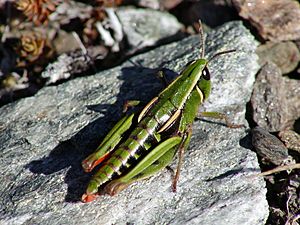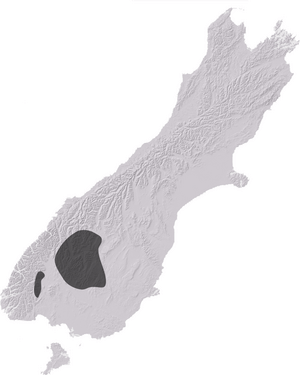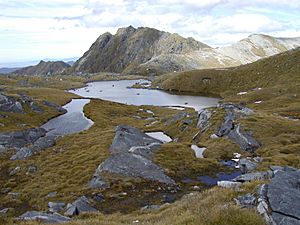Alpinacris tumidicauda facts for kids
Quick facts for kids Alpinacris tumidicauda |
|
|---|---|
 |
|
| Female | |
| Scientific classification | |
| Kingdom: | |
| Phylum: | |
| Class: | |
| Order: | |
| Family: | |
| Genus: |
Alpinacris
|
| Species: |
A. tumidicauda
|
| Binomial name | |
| Alpinacris tumidicauda Bigelow, 1967
|
|
 |
|
| The distribution of A. tumidicauda in New Zealand | |
The Alpinacris tumidicauda is a special kind of grasshopper. You can only find it in the Otago and Southland areas of New Zealand. This grasshopper belongs to a group called Alpinacris. All grasshoppers in this group live only on the South Island of New Zealand.
A scientist named Robert Sidney Bigelow first described this grasshopper in 1967. He found it near a place called Obelisk (also known as Māori: Kopuwai) in the Old Man Range. Like other grasshoppers that live in New Zealand's mountains, A. tumidicauda has a life cycle that takes 2 or 3 years. Their eggs need to stay through winter before they hatch. Young grasshoppers, called hoppers, can be seen all year. Adult grasshoppers are usually found during the New Zealand summer, from December to April. Adult A. tumidicauda do not survive the winter.
Where Does This Grasshopper Live?
The Alpinacris tumidicauda grasshopper lives only in the Otago and Southland regions of New Zealand. You can find them as far south as Cleughearn Peak and as far north as Mount Aurum.
These grasshoppers love to live in alpine tussock grasslands. These are grassy areas high up in the mountains, usually between 1,300 and 1,700 meters (about 4,265 to 5,577 feet) high. Sometimes, they can be found lower down, around 700 meters (about 2,296 feet), especially near the Nevis River. A. tumidicauda is one of three types of alpine grasshoppers found in Fiordland. The other two are Sigaus homerensis and Sigaus takahe.
Alpinacris tumidicauda has a close relative called Alpinacris crassicauda. Long ago, there was only one type of Alpinacris grasshopper on the South Island. But over time, the Alpine Fault, a big crack in the Earth's crust, slowly separated them. Now, there are two different species: A. tumidicauda in the southeast and A. crassicauda in the northwest.
What Does A. tumidicauda Look Like?
The A. tumidicauda grasshopper has very small wings, only about 2 to 4 millimeters (0.08 to 0.16 inches) long. This means it cannot fly, just like most other New Zealand grasshoppers.
Male grasshoppers are about 12 to 14 millimeters (0.47 to 0.55 inches) long. Female grasshoppers are larger, measuring about 21 to 24 millimeters (0.83 to 0.94 inches) long.
Different Colors of A. tumidicauda
Adult A. tumidicauda grasshoppers can come in four different colors. They can be green, olive, dark olive, or yellow-brown. The most common color you will see is green. The next most common color is yellow-brown.






